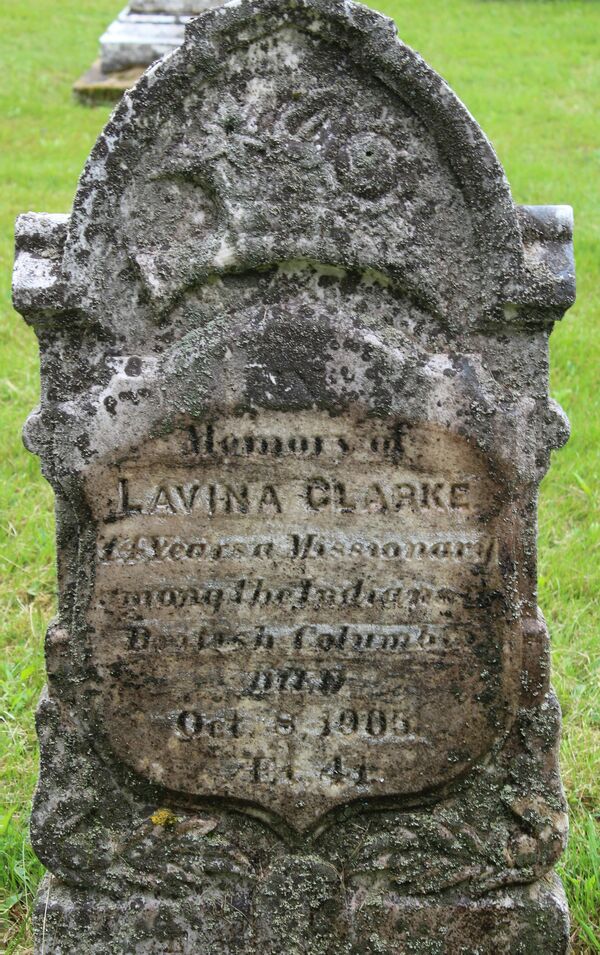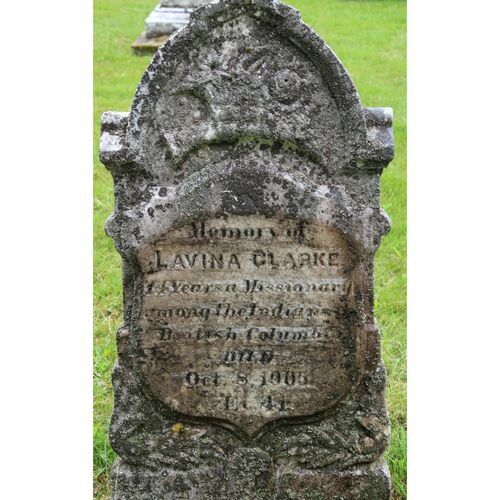
Source: Link
CLARKE, LAVINIA, missionary; b. c. 1864 in Prince Edward Island, possibly the daughter of David Clark of East River and Maria Gay; d. unmarried 8 Oct. 1905 of “valvular trouble of the heart” in Charlottetown.
Lavinia Clarke may have been the Livina Clarke, aged 16, who was living in the household of Albert Gay of Queens County, P.E.I., at the time of the 1881 census. Early in her life Lavinia Clarke began to train as a teacher, but her effort was cut short by the chronic illness that was to beset her throughout her adult years.
Clarke’s interest in missionary work began in the mid 1880s in her local community of Pownal, P.E.I. The latter half of the 19th century saw the rapid expansion of women’s lay missionary associations in Canada. The Methodist Woman’s Missionary Society, which she joined, was arguably the most ambitious of these groups because it exerted direct control over its assets and spread the largest geographical net for its missionary activities. By 1890 it was funding both of the institutions in which Clarke would find work.
In that year Clarke travelled to British Columbia and took up the position of matron in the Coqualeetza Missionary School at Sardis, in the Fraser valley. This step was certainly less than typical for women of her time: most of those who were interested in missions confined themselves to mobilizing support in their local communities [see Catharine Morton*; Jane Buchan; Marjory Laing]; only a small number made the move to actual missionary work [see Susanna Carson; Agnes Maria Turnbull]. In this period institutions among native communities in Canada consolidated and expanded their operations. Imposing buildings which housed schools, hospitals, and other social-welfare agencies brought the federal state and missionaries such as Clarke into the lives of native people in a more concrete and structured manner than had previously been the case. The development of the Coqualeetza school during Clarke’s tenure furnishes a good illustration of how this process took place. When she arrived a small day-school for local native children was in its fourth year of operation. The building was destroyed by fire a year later and a much larger institution, called the Coqualeetza Industrial Institute, was opened in 1894. Funding for the new school came from both the WMS and the federal government. Sixty native students, male and female, now lived full time at the school.
Clarke remained in Sardis until 1895 when she returned to Prince Edward Island on a year’s furlough. Her second posting was at the Crosby Girls’ Home in Port Simpson, on the coast of northern British Columbia. Here she again took the position of matron, caring for approximately 37 residents, and she served until 1902. More is known about Clarke’s life at the Crosby home because she wrote regular reports for the Missionary Outlook, the journal of Canadian Methodist missionaries. Her writings from Port Simpson reveal a profound belief that she was called to and supported in her work by divine forces. Despite the many illnesses and deaths among the students, and continued resistance from parents, Clarke maintained, “Personally, I must confess to a conviction that the future will justify our present course, and that the Home work will remain.” Her task, as she saw it, was to transform native society by training the young women to be good Christians and competent home-makers. Clarke’s perception of the indigenous culture and society as unhealthy and inferior was shared by many missionaries and government agents who built, funded, and administered health and education facilities for natives in 19th- and 20th-century Canada. The stone on her grave in the Pownal United Methodist Cemetery was placed there in her memory by her fellow missionaries.
NA, RG 31, C1, 1881, Queens County (copy at P.E.I. Museum). P.E.I. Museum, Geneal. Div., Marriage book no.8 (1862–67): 63; Pownal United Methodist Cemetery transcript. Jean Barman, The west beyond the west: a history of British Columbia (Toronto, 1991), 154–55, 161. J. W. Grant, Moon of wintertime: missionaries and the Indians of Canada in encounter since 1534 (Toronto, 1984), 175. Isobel McFadden, Living by bells: a narrative of five schools in British Columbia, 1874–1970 ([Toronto?], 1971; copy in UCC-C), 3. Missionary Outlook (Toronto), 14 (1896)–21 (1902), esp. 17 (1899): 190, 263; 18 (1900): 166. Wendy Mitchinson, “Canadian women and church missionary societies in the nineteenth century: a step towards independence,” Atlantis (Wolfville, N.S.), 2 (1977), no.2: 61. Mrs W. E. [Elizabeth] Ross, “In affectionate remembrance of Miss Lavinia Clarke,” Missionary Outlook, 24 (1905): 284–85.
Cite This Article
Megan Barker Davies, “CLARKE, LAVINIA,” in Dictionary of Canadian Biography, vol. 13, University of Toronto/Université Laval, 2003–, accessed January 18, 2026, https://www.biographi.ca/en/bio/clarke_lavinia_13E.html.
The citation above shows the format for footnotes and endnotes according to the Chicago manual of style (16th edition). Information to be used in other citation formats:
| Permalink: | https://www.biographi.ca/en/bio/clarke_lavinia_13E.html |
| Author of Article: | Megan Barker Davies |
| Title of Article: | CLARKE, LAVINIA |
| Publication Name: | Dictionary of Canadian Biography, vol. 13 |
| Publisher: | University of Toronto/Université Laval |
| Year of publication: | 1994 |
| Year of revision: | 1994 |
| Access Date: | January 18, 2026 |



